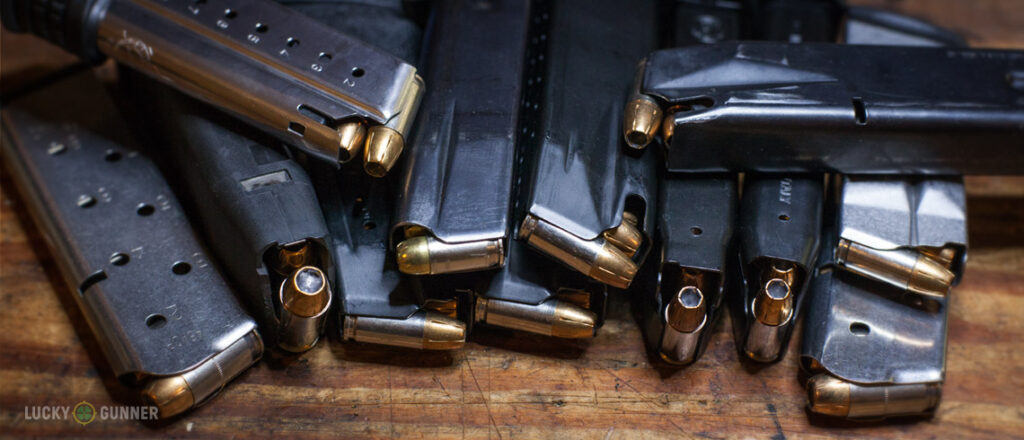If you use a semi-auto for concealed carry or home defense, then there’s a pretty good chance that you keep at least one magazine loaded at all times. Do magazine springs wear out prematurely from keeping the mags loaded for long periods of time? It’s been debated for ages, and the argument continues today, so that makes it a perfect topic to tackle in today’s Make Up Your Mind Monday.
Can You Leave Your Magazines Loaded?
It’s Complicated
If you skipped the video, the short answer is “yes.” Or no. Maybe… nobody really knows for sure.
In theory, if you started with a brand new magazine and loaded it to full capacity, then left it in a drawer, it should not lose a significant amount of spring tension for a very, very long time. Probably years. But reality is messier than that. Tiny variances in the materials and processes used to make the spring can lead to unpredictable results, and there are always outside factors like moisture/corrosion, dust and debris, and ammunition-related issues that can cause the magazine to fail before the spring would actually wear out naturally.
Using the spring (loading and unloading the magazine) frequently will cause it to wear out as well. But if you’re using it a lot, you’ll be able to tell when the spring starts to weaken because the rounds will be much easier to load, and the gun will eventually start experiencing malfunctions at the range. The spring should last tens of thousands of cycles before this occurs, but it will happen eventually. When it becomes apparent that the spring is “done”, either replace it, or replace the entire magazine.
When left loaded to full capacity and not used, most magazines will very slowly lose some amount of spring tension over time. Unfortunately, it’s impossible to say with any certainty just how long it will take before the spring loses enough tension to start causing issues. Some springs may stay loaded for decades and still function, and others might wear out after a much shorter period of time. So just to be safe, the best practice is to rotate the magazines periodically. That’s where you unload your magazines and let them “rest” for a while, and switch to a second set of magazines to keep loaded for the next cycle.
How often is “periodically”? That’s a great question. A gunsmith at Beretta (who claimed not to be speaking on behalf of the company) told us he rotates his personal carry magazines every two weeks. The customer service rep we spoke to from Sig said that once every six months would be sufficient. However David Cochol of Mec-Gar, the company that manufactures the factory magazines for Sig (as well as Ruger, S&W, CZ, and several others), gave us the answer that seemed most common; “We recommend following standard law enforcement practice and that’s to rotate magazines every 90 days.” He also suggested that rotation as a good opportunity to field strip, clean, and inspect the magazines to make sure there aren’t any other problems that could cause malfunctions. Polymer followers in particular seem to be a common failure point for magazines.
Down-Loading
Adding some complexity to this debate is whether loading the mags to their full capacity will make any difference in how quickly the springs wear out. It’s not rare to hear the advice that a 17-round Glock magazine, for example, should only be loaded up to 15 or 16 rounds in order to spare the spring from any unnecessary stress. Many people will cite the common practice of leaving 30-round AR-15 magazines loaded to only 28 or 29 rounds because it’s difficult to seat a fully loaded 30-round magazine into the mag well when the bolt is closed. But that’s an issue specific only to certain firearms, and separate from the longevity of spring tension.
Again, there is not a clear consensus in the industry. Mec-Gar’s rep stated that it’s unnecessary to down-load magazines and that doing so is not relieving enough tension to make any appreciable difference in the life of the spring. “If you’ve got a 15-round magazine, you’re not doing yourself any favors by making it a 14-round magazine,” Cochol said.
However, Wolff Gunsprings, a company well known for manufacturing a wide variety of springs for the firearms industry has a slightly different take. The FAQ page on their website includes this statement; “More recently higher capacity magazine have become popular. These are designed to hold more rounds with less spring material often in the same space. This puts more stress on the spring and will cause it to fatigue at a faster rate. Unloading these magazines a round or two will help the life of the spring.” It’s not clear to what degree this practice will supposedly “help the life of the spring”, but most of the other industry representatives we spoke with didn’t believe it was necessary if the magazines were rotated regularly.
The Bottom Line on Magazine Springs
Magazines and magazine springs wear out. They aren’t designed to last forever whether they are used often, or loaded up and left to sit for years at a time. The various firearms and magazine manufacturers didn’t exactly agree on the specifics, but many of them did say that it’s common for customers to blame magazine spring tension for issues completely unrelated. De-formed followers, bad ammunition, problematic firearms, and user error are more often to blame for frequent malfunctions than worn magazine springs. The best way to avoid any of these issues is to keep a regular maintenance schedule and carefully clean and inspect both your magazines and firearms. Or just buy a revolver.


